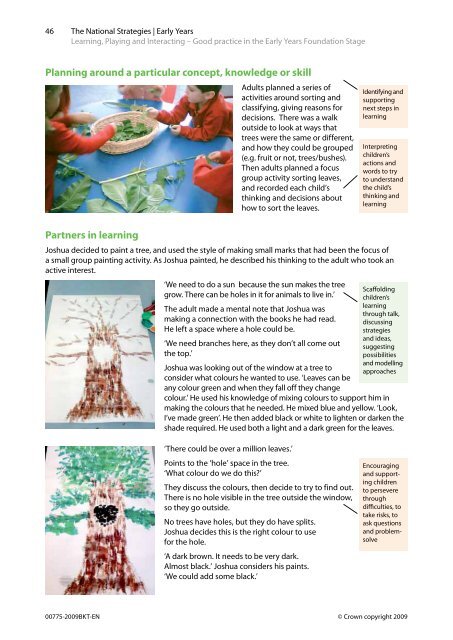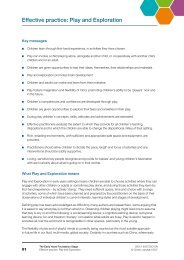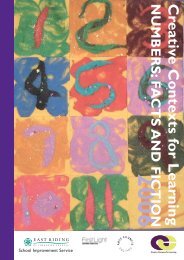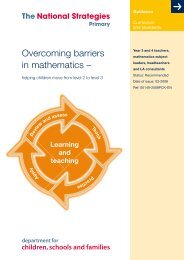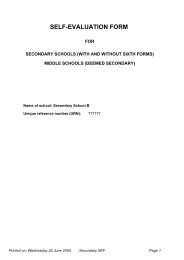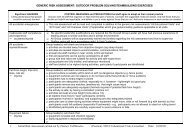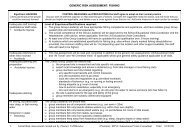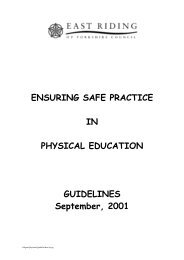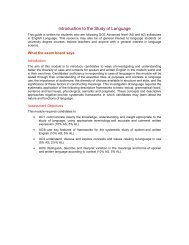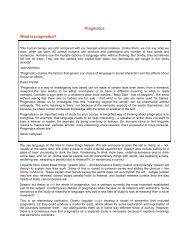Learning, Playing and Interacting - Good practice in the Early Years ...
Learning, Playing and Interacting - Good practice in the Early Years ...
Learning, Playing and Interacting - Good practice in the Early Years ...
You also want an ePaper? Increase the reach of your titles
YUMPU automatically turns print PDFs into web optimized ePapers that Google loves.
46 The National Strategies | <strong>Early</strong> <strong>Years</strong><br />
<strong>Learn<strong>in</strong>g</strong>, <strong>Play<strong>in</strong>g</strong> <strong>and</strong> <strong>Interact<strong>in</strong>g</strong> – <strong>Good</strong> <strong>practice</strong> <strong>in</strong> <strong>the</strong> <strong>Early</strong> <strong>Years</strong> Foundation Stage<br />
Plann<strong>in</strong>g around a particular concept, knowledge or skill<br />
Adults planned a series of<br />
activities around sort<strong>in</strong>g <strong>and</strong><br />
classify<strong>in</strong>g, giv<strong>in</strong>g reasons for<br />
decisions. There was a walk<br />
outside to look at ways that<br />
trees were <strong>the</strong> same or different,<br />
<strong>and</strong> how <strong>the</strong>y could be grouped<br />
(e.g. fruit or not, trees/bushes).<br />
Then adults planned a focus<br />
group activity sort<strong>in</strong>g leaves,<br />
<strong>and</strong> recorded each child’s<br />
th<strong>in</strong>k<strong>in</strong>g <strong>and</strong> decisions about<br />
how to sort <strong>the</strong> leaves.<br />
Identify<strong>in</strong>g <strong>and</strong><br />
support<strong>in</strong>g<br />
next steps <strong>in</strong><br />
learn<strong>in</strong>g<br />
Interpret<strong>in</strong>g<br />
children’s<br />
actions <strong>and</strong><br />
words to try<br />
to underst<strong>and</strong><br />
<strong>the</strong> child’s<br />
th<strong>in</strong>k<strong>in</strong>g <strong>and</strong><br />
learn<strong>in</strong>g<br />
Partners <strong>in</strong> learn<strong>in</strong>g<br />
Joshua decided to pa<strong>in</strong>t a tree, <strong>and</strong> used <strong>the</strong> style of mak<strong>in</strong>g small marks that had been <strong>the</strong> focus of<br />
a small group pa<strong>in</strong>t<strong>in</strong>g activity. As Joshua pa<strong>in</strong>ted, he described his th<strong>in</strong>k<strong>in</strong>g to <strong>the</strong> adult who took an<br />
active <strong>in</strong>terest.<br />
‘We need to do a sun because <strong>the</strong> sun makes <strong>the</strong> tree<br />
grow. There can be holes <strong>in</strong> it for animals to live <strong>in</strong>.’<br />
The adult made a mental note that Joshua was<br />
mak<strong>in</strong>g a connection with <strong>the</strong> books he had read.<br />
He left a space where a hole could be.<br />
‘We need branches here, as <strong>the</strong>y don’t all come out<br />
<strong>the</strong> top.’<br />
Scaffold<strong>in</strong>g<br />
children’s<br />
learn<strong>in</strong>g<br />
through talk,<br />
discuss<strong>in</strong>g<br />
strategies<br />
<strong>and</strong> ideas,<br />
suggest<strong>in</strong>g<br />
possibilities<br />
<strong>and</strong> modell<strong>in</strong>g<br />
approaches<br />
Joshua was look<strong>in</strong>g out of <strong>the</strong> w<strong>in</strong>dow at a tree to<br />
consider what colours he wanted to use. ‘Leaves can be<br />
any colour green <strong>and</strong> when <strong>the</strong>y fall off <strong>the</strong>y change<br />
colour.’ He used his knowledge of mix<strong>in</strong>g colours to support him <strong>in</strong><br />
mak<strong>in</strong>g <strong>the</strong> colours that he needed. He mixed blue <strong>and</strong> yellow. ‘Look,<br />
I’ve made green’. He <strong>the</strong>n added black or white to lighten or darken <strong>the</strong><br />
shade required. He used both a light <strong>and</strong> a dark green for <strong>the</strong> leaves.<br />
‘There could be over a million leaves.’<br />
Po<strong>in</strong>ts to <strong>the</strong> ‘hole’ space <strong>in</strong> <strong>the</strong> tree.<br />
‘What colour do we do this’<br />
They discuss <strong>the</strong> colours, <strong>the</strong>n decide to try to f<strong>in</strong>d out.<br />
There is no hole visible <strong>in</strong> <strong>the</strong> tree outside <strong>the</strong> w<strong>in</strong>dow,<br />
so <strong>the</strong>y go outside.<br />
No trees have holes, but <strong>the</strong>y do have splits.<br />
Joshua decides this is <strong>the</strong> right colour to use<br />
for <strong>the</strong> hole.<br />
‘A dark brown. It needs to be very dark.<br />
Almost black.’ Joshua considers his pa<strong>in</strong>ts.<br />
‘We could add some black.’<br />
Encourag<strong>in</strong>g<br />
<strong>and</strong> support<strong>in</strong>g<br />
children<br />
to persevere<br />
through<br />
difficulties, to<br />
take risks, to<br />
ask questions<br />
<strong>and</strong> problemsolve<br />
00775-2009BKT-EN © Crown copyright 2009


